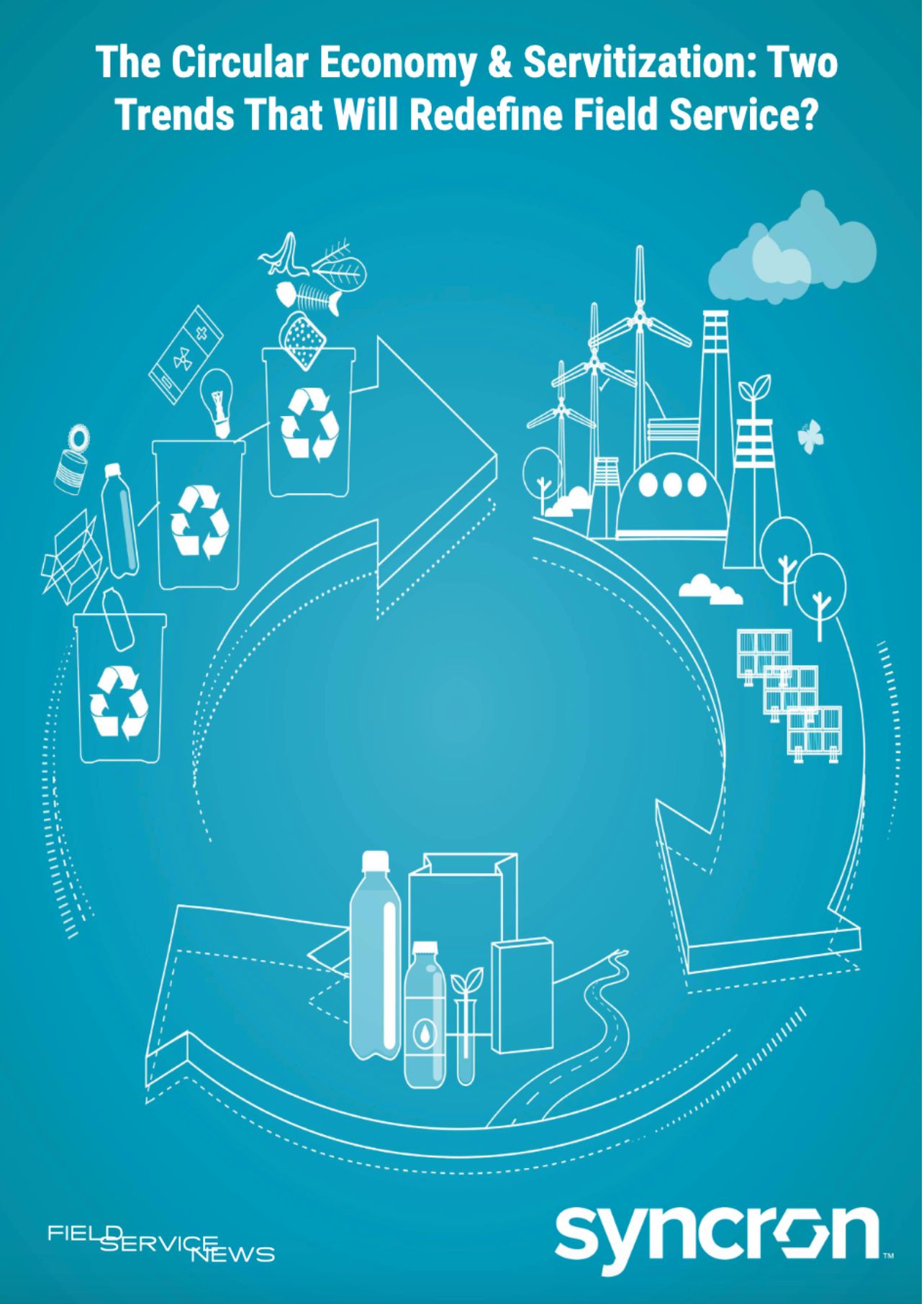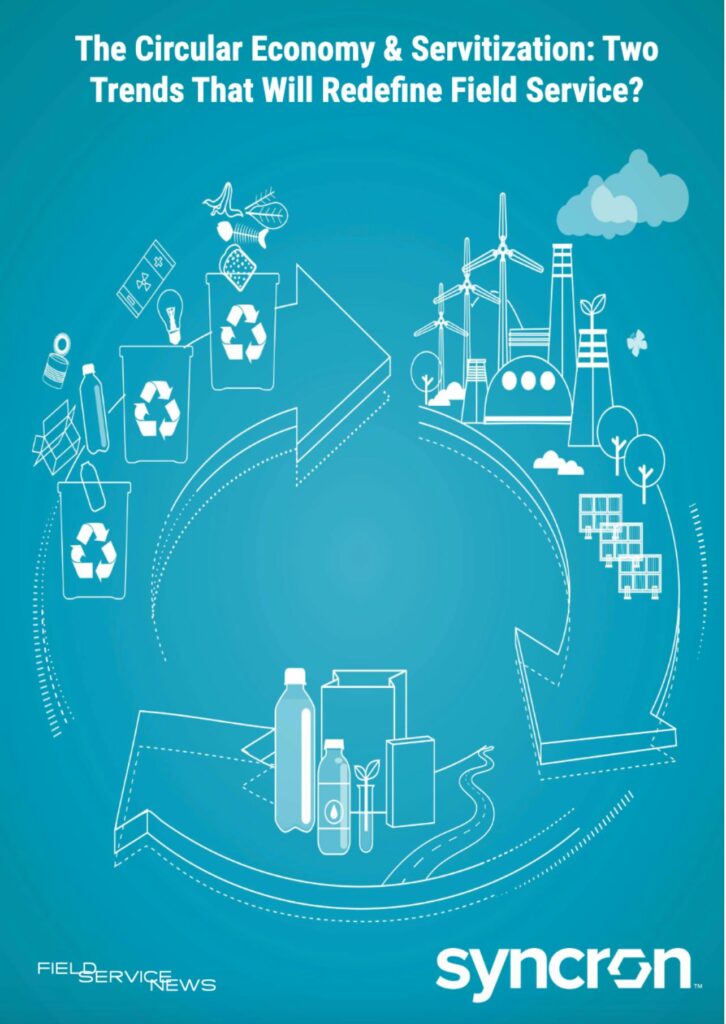The Circular Economy and Servitization in Practice
The Circular Economy and Servitization in Practice
As we saw in the previous feature, the circular economy and servitization offer exciting opportunities for field service management professionals to create more sustainable and profitable business models.
In this second extract from the white paper, we will take a closer look at how companies worldwide have implemented these concepts.
Principles of the Circular Economy in Practice
The circular economy seeks to create a closed-loop system where resources are kept in use through repair, reuse, and recycling. The circular economy can reduce waste, optimize resource use, and create new revenue streams through recycling and upcycling. In practice, companies can adopt a variety of circular economy practices to achieve these goals.
The concept of a circular economy is not new, and the idea of an economy that aims to minimize waste and maximize the use of resources has been around since the 1960s. However, it has gained greater traction in recent years as the world has become increasingly aware of the environmental impact of our linear “take-make-dispose” economic model.
The last decade has seen a growing recognition of the need for a more sustainable economic model. The circular economy is now recognized as a critical enabler of sustainability and has been adopted by companies and governments worldwide.
Its principles are being applied across various industries, from automotive and electronics to fashion and food, to reduce waste, increase resource efficiency, and create new business opportunities.
One example of circular economy practices in action is the concept of product as a service (PaaS). PaaS involves leasing or renting products to customers rather than selling products outright. This model incentivizes manufacturers to design durable products that can be easily maintained and repaired, as they are responsible for the products’ upkeep during the leasing period. PaaS can create new revenue streams for manufacturers while reducing waste and extending product lifetimes.
Another example of circular economy practices is the concept of closed-loop supply chains. In a closed-loop supply chain, products are designed for disassembly and recycling, with manufacturers responsible for taking back end-of-life products and recovering materials for reuse. By doing so, companies can reduce their reliance on virgin materials and create new revenue streams through recycling and upcycling.
Principles of Servitization in Practice
Product as a Service (PaaS) and servitization are closely aligned, as both concepts emphasize delivering outcome-based solutions through a combination of products and services. Indeed, under some definitions, they are even used interchangeably.
PaaS provides a technology platform for companies to develop, deliver and manage these solutions, while servitization focuses on delivering the outcomes and services that support customers’ needs. These concepts offer exciting opportunities to create more sustainable and profitable business models in the field service industry.
Servitization involves offering a combination of products and services to provide outcome-based solutions for customers. By doing so, companies can build stronger customer relationships, generate new revenue streams, and reduce their environmental impact. In practice, companies can adopt a variety of servitization practices to achieve these goals.
One example of servitization practices in action is the concept of product-service systems (PSS). PSS involves offering a bundle of products and services to deliver specific customer outcomes rather than simply selling products. This model incentivizes manufacturers to focus on delivering outcomes rather than just selling products and can create new revenue streams through ongoing service contracts.
Another example of servitization practices is the concept of outcome-based contracts. In an outcome-based contract, manufacturers are responsible for delivering specific customer outcomes, such as uptime, rather than simply providing products. This model incentivizes manufacturers to design reliable and easy-to-maintain products, as they are responsible for ensuring the products deliver the desired outcomes.


Data usage note: By accessing this content you consent to the contact details submitted when you registered as a subscriber to fieldservicenews.com to be shared with the listed sponsor of this premium content Syncron who may contact you for legitimate business reasons to discuss the content of this briefing report.
This content is available for FSN PRO members and also for a limited period for FSN FREE members. Please make sure you are logged in to access this content.
Not yet subscribed? Instantly unlock this content and more on our forever-free subscription tier FSN FREE
Join FSN FREE today!
Subscribe to our forever-free subscription tier FSN FREE by completing the brief form below and get instant access to this resource plus a selection of premium resources every month.
[pmpro_signup submit_button=”Get access now!” level=”1″ redirect=”referrer” custom_fields=”true” short=”true”]
Some browsers may not support our quick-register pop up function. If you cannot see a red button above this message then click here to head to the FSN FREE registration page instead.
"Circular services involve offering outcome-based services designed to promote circular economy principles, such as repair and maintenance services extending product lifespan.........”
Circular Services: Combining Circular Economy and Servitization Practices
Companies can create even more sustainable and innovative business models by combining circular economy and servitization practices.
For example, a company could offer product as a service (PaaS) with closed-loop supply chain principles, meaning the company leases durable products to customers and takes them back for recycling and upcycling at the end of their lifetimes. By doing so, the company can reduce waste, extend product lifetimes, and create new revenue streams through recycling and upcycling.
Another example of combining circular economy and servitization practices is the concept of circular services. Circular services involve offering outcome-based services designed to promote circular economy principles, such as repair and maintenance services extending product lifespan. By doing so, companies can create new revenue streams while reducing their environmental impact.
Examples of Circular Economy and Servitization in Action
Many companies worldwide have successfully implemented circular economy and servitization practices to create more sustainable and profitable business models.
One such company is Philips, which has embraced circular economy and servitization practices in its healthcare business. Philips has shifted its focus from selling products to providing services and solutions that deliver specific outcomes for its customers, such as improved patient outcomes and reduced healthcare costs. By offering solutions that deliver these outcomes, Philips has built stronger customer relationships, generated new revenue streams, and reduced its environmental impact.
Another example is Caterpillar, a heavy equipment manufacturer for the construction and mining industries. Caterpillar has implemented a range of circular economy and servitization practices, such as offering remanufactured components for its equipment and leasing equipment instead of selling it outright. By remanufacturing components, Caterpillar has been able to extend the lifespan of its equipment and reduce the need for new raw materials. By offering equipment leasing, Caterpillar has created new revenue streams and reduced its products’ environmental impact.
These examples demonstrate the potential of circular economy and servitization practices to drive sustainability and innovation in the field service industry. We shall look in further detail at these and European carpet manufacturer Desso later in this paper.
What is evident from such examples is that by adopting these practices, field service management professionals can create more sustainable and profitable business models while delivering better outcomes for their customers and the planet.
In the next feature, we’ll discuss the challenges and opportunities associated with adopting a circular economy and servitization practices in field service management.

Do you want to know more?
If you are already a subscriber you can access the report instantly on the ‘read now’ button below. If the button is not showing and you are already a subscriber then please log-in and refresh this page.
Not yet subscribed? Instantly unlock this content and more on our forever-free subscription tier FSN FREE
Join FSN FREE today!
Subscribe to our forever-free subscription tier FSN FREE by completing the brief form below and get instant access to this resource plus a selection of premium resources every month.
[pmpro_signup submit_button=”Get access now!” level=”1″ redirect=”referrer” custom_fields=”true” short=”true”]
Some browsers may not support our quick-register pop up function. If you cannot see a red button above this message then click here to head to the FSN FREE registration page instead.

 Data usage note: By accessing this content you consent to the contact details submitted when you registered as a subscriber to fieldservicenews.com to be shared with the listed sponsor of this premium content Syncron who may contact you for legitimate business reasons to discuss the content of this briefing report.
Data usage note: By accessing this content you consent to the contact details submitted when you registered as a subscriber to fieldservicenews.com to be shared with the listed sponsor of this premium content Syncron who may contact you for legitimate business reasons to discuss the content of this briefing report.


